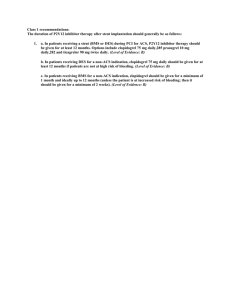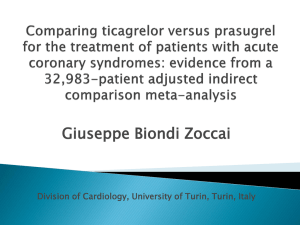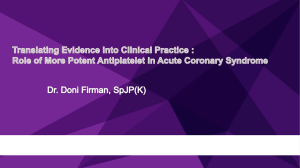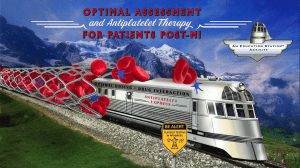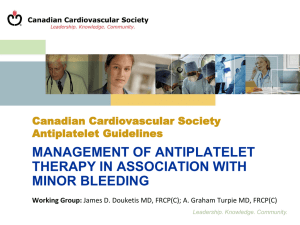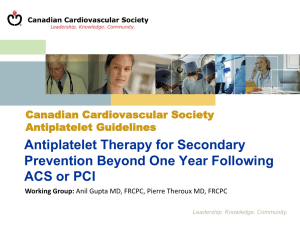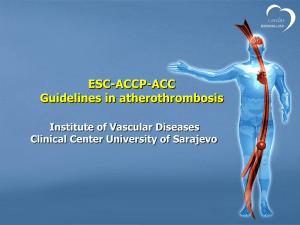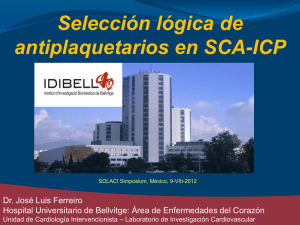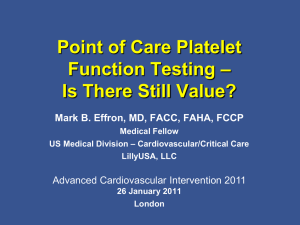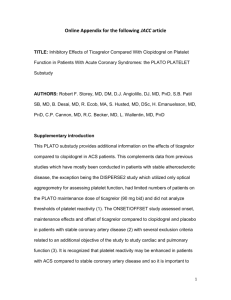The Evolution of Antiplatelet Therapy in ACS and PCI
advertisement
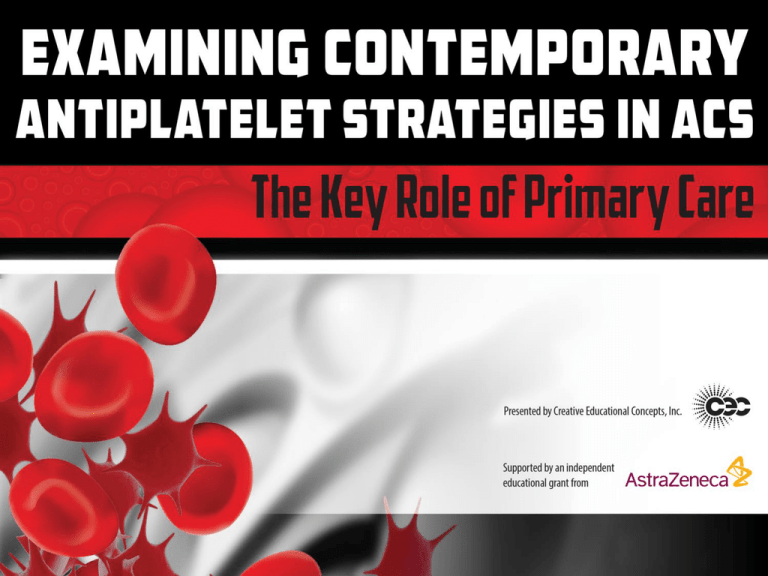
Presenting Faculty: Tomas Villanueva, DO, MBA, FACPE, SFHM Clinical Assistant Professor of Medicine College of Osteopathic Medicine Nova Southeastern University Medical Director, Hospital Medicine Program Baptist Health System of Miami Miami, FL Dr. Villanueva has disclosed that he is a consulting editor for Hospital Medicine Program Management and a reviewer for Hospital Medicine. He is also on the speakers’ bureaus for American Regent, AstraZeneca, Forest, Novo Nordisk, and Pfizer. Pre-test 67 year old man with history of DM and GI bleed six months ago is admitted with NSTE-ACS. Initial ECG showed anterolateral ST depressions and troponin levels rose to 1.3. He undergoes stenting of the LAD with a drug-eluting stent (DES). He is discharged to your care for further management. % % % % What is the most appropriate daily dose of aspirin to treat him with long-term? A. B. C. D. 81 mg QD 325 mg (enteric coated) QD 325 mg BID (to better prevent stent thrombosis) It doesn’t matter 10 Countdown How long should his P2Y12 inhibitor therapy (clopidogrel, ticagrelor, or prasugrel) be continued? A. B. C. D. One month 3-6 months At least 12 months It depends on which P2Y12 inhibitor he was placed on 10 Countdown Should the patient be placed on a PPI? 25% 25% 25% 25% A. B. C. D. It depends Yes No Maybe 10 Countdown Pathophysiology of Plaque Rupture and Acute Coronary Syndromes Coronary Atherosclerotic Plaque • Coronary artery smooth muscle thickening • Foam cells accumulate in smooth muscle • Core of extracellular lipid accumulates Ruptured Vulnerable Plaque with Thrombus Formation Ruptured Vulnerable Fibrous Cap Thrombus Plaque Core Plaque Rupture with Coronary Thrombus Platelet Aggregation Platelet Cascade in ACS 1 Adhesion 2 Activation Thrombin Platelets von Willebrand Factor/GP lb Bind ADP 5 HT Collagen GP la/lla Bind Lipid Core TXA2 3 Aggregation 4 Platelet Plug Activated GP llb/llla Fibrinogen Schafer AI. Am J Med. 1996. Mortality in the Global Registry of Acute Coronary Events (GRACE) % Mortality 16 STEMI 12 Mortality from D/C to six months STEMI – 4.8% NSTEMI – 6.2% Unstable – 3.6% 8 NSTEMI UA 4 0 0 30 60 90 120 Days 150 180 N=43,810 Fox KA, et al. BMJ. 2006; Goldberg RJ, et al. Am J Cardiol. 2004. Aspirin for ACS and Secondary Prevention Aspirin in Acute Coronary Syndromes (ACS) Acute MI Unstable Angina P<.0001 Death or MI Patients (%) 20 P=.001 Reocclusion 30 17.1 P=.012 MI 4 25.0 15 3.3 15 11.8 3 20 11.0* 6.5* 1.9* 2 10 5 5 Placebo N= 397 9.4* 10 10 0 P<.001 Vascular Death 1 ASA 399 0 Placebo 513 ASA 419 0 Placebo 8,587 ASA 8,600 0 Placebo 8,587 ASA 8,600 MI=myocardial infarction ASA=acetylsalicylic acid RISC=Research on Instability in Coronary Artery Disease RISC Group. Lancet. 1990; Roux S, et al. J Am Coll Cardiol. 1992; ISIS-2. Lancet. 1988. Chronic ASA Doses and Vascular Events in High Risk Patients Antithrombotic Trialists Collaboration. Br Med J. 2002. Relationship Between Major Bleeding and ASA Dose in ACS Patients Post-hoc Analysis from CURE ASA + Clopidogrel ASA + Placebo Incidence of Major Bleeding (%) 4.9% 5.0 3.7% 4.0 3.4% 3.0% 3.0 2.0 2.8% 1.9% 1.0 0 ≤100 mg (N=5,320) 101–199 mg ≥200 mg (N=3,109) (N=4,110) ASA dose (range 75-325 mg) Peters RJ, et al. Circulation. 2003. Aspirin Dosing After ACS/PCI: Current ACCF/AHA Recommendations • UA/NSTEMI (2011 Focused Update):1 • 75-162 mg indefinitely • STEMI (2004 Guideline):2 • 75-162 mg indefinitely • Secondary Prevention (2011 Update):3 • 75-162 mg indefinitely • PCI (2011 Guideline):4 • Aspirin indefinitely (class I; LOE A) • Reasonable to use 81 mg/day in preference to higher maintenance doses (class IIa; LOE B) 1Wright RS, et al. Circulation. 2011; 2Antman EM, et al. J Am Coll Cardiol. 2004; 3Smith S, et al. J Am Coll Cardiol. 2011; 4Levine GN. J Am Coll Cardiol. 2011. Clopidogrel After NSTE-ACS CURE Trial: Primary Composite Endpoint (MI/CVA/CV Death) at 12 Months in Patients with NSTE-ACS 11.4% 12 % With Event 20% RRR P=.00009 Placebo + Aspirin 14 9.3% 10 Clopidogrel + Aspirin 8 6 4 2 0 3 6 9 12 Follow-up (Months) Yusuf S, et al. N Engl J Med. 2001. Clopidogrel For Primary and Secondary Prevention CHARISMA Trial Design (Clopidogrel in Addition to Aspirin in Patients Without Recent ACS) Patients age ≥45 years at high risk of atherothrombotic events* (N=15,603) Low dose ASA 75-162 mg/day R Clopidogrel 75 mg/day (N=7,802) Double-blind treatment up to 1040 primary efficacy events (CV death, MI or CVA) Low dose ASA 75-162 mg/day *Documented CAD, CVD, symptomatic PAD or >=2 CRF Placebo 1 tablet/day (N=7,801) 1-month visit 3-month visit Visits every 6 months Final visit (Fixed study end date) Bhatt DL, et al. Am Heart J. 2004. Cumulative event rate (%) CHARISMA: Overall Population: Primary Efficacy Outcome (MI, Stroke, or CV Death)† 8 Placebo + ASA* 7.3% 6 Clopidogrel + ASA* 6.8% 4 RRR: 7.1% [95% CI: -4.5%, 17.5%] P=.22 2 0 0 6 12 18 24 30 Months since randomization§ † First Occurrence of MI (fatal or non-fatal), stroke (fatal or non-fatal), or cardiovascular death *All patients received ASA 75-162 mg/day §The number of patients followed beyond 30 months decreases rapidly to zero and there are only 21 primary efficacy events that occurred beyond this time (13 clopidogrel and 8 placebo) Bhatt DL, et al. N Engl J Med. 2006. CHARISMA Primary Efficacy Results (MI/Stroke/CV Death) by Pre-Specified Entry Category Population RR (95% CI) Qualifying CAD, CVD or PAD P value 0.88 (0.77, 0.998) .046 1.20 (0.91, 1.59) .20 0.93 (0.83, 1.05) .22 (N=12,153) Multiple Risk Factors (N=3,284) Overall Population* (N=15,603) 0.4 0.6 0.8 Clopidogrel Better 1.2 1.4 1.6 Placebo Better *A statistical test for interaction showed marginally significant heterogeneity (P=.045) in treatment response for these pre-specified subgroups of patients Bhatt DL, et al. N Engl J Med. 2006. Primary Outcome Event Rate (%) CHARISMA – Prior MI 10 N=3,846 8.3% 8 Placebo + ASA Clopidogrel + ASA 6.6% 6 4 2 HR=0.774 (95% CI [0.613–0.978]) P=.031 0 0 6 12 18 24 Months Since Randomization Bhatt DL, et al. J Am Coll Cardiol. 2007. 30 Clopidogrel should be considered in a non-diabetic patient with high risk for atherosclerosis but has not had an episode of ACS. A. True B. False 10 Countdown P2Y12 Inhibitor Therapy After Stenting Coronary Stenting Lesion crossed with guidewire Lesion dilated with balloon Stent aligned in lesion Deployed stent In artery Coronary Stenting Pre-PTCA Post-Balloon Post-Stent CREDO: One Year Primary Outcome Stable CAD and ACS Patients Rx with Bare Metal Stents (BMS) 27% RRR P=.02 Death, MI, or Stroke 15 Placebo N=1063 11.5% 10 8.5% Clopidogrel N=1,053 5 0 0 3 6 9 12 Months Steinhubl SR, et al. JAMA. 2002. Continued Risk of Drug Eluting Stent (DES) Thrombosis Stent Thrombosis (%) DES Stent Thrombosis In The Bern/Rotterdam Two Center Experience 14 Paclitaxel DES 3 2 Sirolimus DES 1 0 0 365 730 1,095 Days After Stenting P. Wenaweser and P.W. Serruys, ESC 2006. (Slide courtesy of Roxana Mehran, Columbia University) Newer P2Y12 Inhibitors ∙ Prasugrel ∙ Ticagrelor Prasugrel • Thienopyridine • “Irreversible” platelet inhibition • Rapidly metabolized prodrug • Rapid onset of action • Greater and more reliable platelet inhibition than clopidogrel Bhatt DL. N Engl J Med. 2009; van Giezen JJ. Eur Heart J Suppl. 2008. PRINCIPLE-TIMI 44 Prasugrel vs. Clopidogrel Loading Dose Maintenance Doses Inhibition of Platelet Aggregation (%) 100 80 * † ** † † Pras 10 mg * * * * * * * § Clop 75 mg ! * 40 * Clop 600 mg Pras 60 mg 60 * Clop 75 mg ! 20 Clop 300 mg *P<.001 vs. Clop 300 mg mean ± SEM 20 μM ADP 0 0 0.25 0.5 Time 1 2 Hours 4 6 24 3 4 5 6 7 8 9 or 600 mg LD P<.001 vs. Clop 300 ! P<.05 vs. Clop 300 §P<.05 vs. Clop 300/75 † Days Wiviott SD, et al. Circulation. 2007. TRITON-TIMI 38: Study Design ACS (STEMI or UA/NSTEMI) and Planned PCI ASA N=13,600 Double-blind CLOPIDOGREL 300 mg LD/75 mg MD PRASUGREL 60 mg LD/10 mg MD Median duration of therapy: 12 months 1o endpoint: 2o endpoints: CV death, MI, Stroke CV death, MI, Stroke, Rehospitalization for Recurrent Ischemia CV death, MI, UTVR Stent Thrombosis (ARC definite/prob.) Safety endpoints: TIMI major bleeds, Life-threatening bleeds Key Substudies: Pharmacokinetic, Genomic LD=loading dose; MD=maintenance dose Wiviott SD, et al. N Engl J Med. 2007. TRITON-TIMI 38 Timing of Benefit: Landmark Analysis 8 Primary Endpoint (%) (CV death, MI, CVA) Clopidogrel Clopidogrel 6 5.6 4 4.7 5.6 Prasugrel Prasugrel HR 0.82 P=.01 2 6.9 HR 0.80 P=.003 1 0 0 1 2 Loading Dose 3 0 30 60 90 Days 180 270 360 450 Maintenance Dose Wiviott SD, et al. N Engl J Med. 2007. TRITON-TIMI 38: Definite and Probable Stent Thrombosis Definite & Probable Stent Thrombosis (%) 2.5 Clopidogrel Any Stent at Index PCI N=12,844 2.4 (142) 2 1.1 (68) 1 Prasugrel 0 0 30 60 90 180 270 360 HR 0.48 P<.0001 NNT=77 450 Days Wiviott SD, et al. N Engl J Med. 2007. TRITON-TIMI 38: Bleeding Events 4 Prasugrel Clopidogrel ICH in Pts with Prior Stroke/TIA (N=518) % Events P=.03 Clopidogrel 0 (0%) Prasugrel 6 (2.3%) P=.02 2.4 2 1.8 P=.01 P=NS 1.4 0.9 0.9 1.1 P=.002 0.4 0.1 P=NS 0.3 0.3 0 TIMI Major Bleeds ARD 0.6% HR 1.32 ARD=absolute risk difference Life Threatening ARD 0.5% HR 1.52 Nonfatal ARD 0.2% Fatal ARD 0.3% ICH ARD 0% Wiviott SD, et al. N Engl J Med. 2007. TRILOGY ACS Study Design Medically Managed UA/NSTEMI Patients Randomization Stratified by: Age, Country, Prior Clopidogrel Treatment (Primary analysis cohort — Age <75 years) Medical Management Decision ≤72 hrs (No prior clopidogrel given) – 4% of total Clopidogrel* 300 mg LD + 75 mg MD Prasugrel* 30 mg LD + 5 or 10 mg MD Median Time to Enrollment=4.5 Days Medical Management Decision ≤ 10 days (Clopidogrel started ≤72 hrs in-hospital OR on chronic clopidogrel) – 96% of total Clopidogrel* Prasugrel* 75 mg MD 5 or 10 mg MD Minimum Rx Duration: 6 months; Maximum Rx Duration: 30 months Primary Efficacy Endpoint: CV Death, MI, Stroke *All patients were on aspirin and low-dose aspirin (<100 mg) was strongly recommended. For patients <60 kg or ≥75 years, 5 mg MD of prasugrel was given Adapted from Chin CT, et al. Am Heart J. 2010. TRILOGY ACS: Primary Efficacy Endpoint* Primary Efficacy Endpoint (%)** 20 HR ≤1Year: 0.99 HR >1 Year: 0.72 (0.84, 1.16) (0.54, 0.97) 16.0% 13.9% 15 10 Clopidogrel Prasugrel HR: 0.91 P=.21 (NS) 5 Interaction P=.07 0 0 No. at risk Prasugrel: 3,620 Clopidogrel: 3,623 180 360 540 Time, days 3,248 3,244 2,359 2,390 *Primary endpoint=CV death, nonfatal MI, nonfatal stroke **Primary analysis excludes age >75 yrs 1,611 1,596 720 900 953 946 389 399 Roe MT, et al. N Engl J Med. 2012. Ticagrelor •Non-thienopyridine •“Reversible” binding of P2Y12 receptor •Active drug •Quick onset of action •Greater degree of and more reliable platelet inhibition than clopidogrel Bhatt DL. Nature Reviews Cardiology. 2009; van Giezen JJ. Eur Heart J Suppl. 2008. DISPERSE 2 Comparative Effects on Platelet Aggregation of Ticagrelor vs. Clopidogrel Inhibition of Platelet Aggregation (IPA) IPA, % (mean ± SEM) 100 75 Ticagrelor 90 mg Ticagrelor 180 mg 50 Ticagrelor 270 mg Clopidogrel 300 mg 25 0 0 2 4 6 8 10 12 Time Post Dose (Hours) Keeley EC, et al. Lancet. 2006. PLATO Study Design NSTEMI-ACS (moderate-to-high risk), STEMI (if primary PCI) Clopidogrel-treated or -naive; randomized within 24 hours of index event (N=18,624) Clopidogrel If pretreated, no additional loading dose; if naive, standard 300 mg loading dose, then 75 mg QD maintenance; (additional 300 mg allowed pre-PCI) Ticagrelor 180 mg loading dose, then 90 mg BID maintenance; (additional 90 mg pre-PCI) 6-12-month exposure Primary endpoint: CV death + MI + Stroke Primary safety endpoint: Total major bleeding Wallentin L, et al. N Engl J Med. 2009. PLATO: Cumulative incidence (%) Time to Primary Efficacy Endpoint* 13 12 11 10 9 8 7 6 5 4 3 2 1 0 11.7% Clopidogrel 9.8% Ticagrelor HR 0.84 (95% CI 0.77-0.92) P=.0003 0 60 120 180 240 300 360 Days after Randomisation No. at risk Ticagrelor 9,333 8,628 8,460 8,219 6,743 5,161 4,147 Clopidogrel 9,291 8,521 8,362 8,124 6,650 5,096 4,047 *Composite of CV death, MI, or stroke Wallentin L, et al. N Engl J Med. 2009. PLATO: Secondary Efficacy Endpoints Myocardial infarction Clopidogrel 6 5.8 5 Ticagrelor 4 3 HR 0.84 (95% CI 0.75-0.95) P=.005 2 7 6.9 1 Cumulative incidence (%) Cumulative incidence (%) 7 Cardiovascular death 6 Clopidogrel 5 5.1 4.0 Ticagrelor 4 3 2 HR 0.79 (95% CI 0.69-0.91) P=.001 1 0 0 0 60 120 180 240 300 360 Days after randomisation 0 60 120 180 240 300 360 Days after randomisation Wallentin L, et al. N Engl J Med. 2009. PLATO: Overall, Non-CABG and CABG-related Major Bleeding P=.43 (NS) Ticagrelor 13 Estimated Rate (% per year) 12 11.6 Clopidogrel 11.2 11 10 P=.57 (NS) 9 8 7.9 P=.32 (NS) 9 8 7.7 7 7 6 6 5 5 4 4 3 3 2 2 1 1 0 0 PLATO TIMI criteria criteria major major bleeding bleeding 7.4 7.9 P=.32 (NS) P=.026 5.3 5.8 4.5 3.8 P=.025 2.8 2.2 Non-CABG PLATO major bleeding Non-CABG TIMI major bleeding CABG PLATO major bleeding CABG TIMI major bleeding Wallentin L, et al. N Engl J Med. 2009. PLATO: Stent Thrombosis* Stent Thrombosis, % Ticagrelor (N=5,640) Clopidogrel (N=5,649) HR (95% CI) P Value Definite 71 (1.3%) 106 (1.9%) 0.67 (0.52-0.91) .009 Probable of definite 118 (2.1%) 158 (2.8%) 0.75 (0.59-0.95) .02 Possible, probable, or definite 155 (2.8%) 202 (3.6%) 0.77 (0.62-0.95) .01 *Evaluated in patients with any stent during the study Wallentin L, et al. N Engl J Med. 2009. Cardiovascular death, MI, or Stroke (%) PLATO: Initial Non-Invasive Strategy Subgroup •N=5,216 (1/4 total study population, 1/3 NSTE-ACS population) •In-hospital procedures: cath 41.9%; PCI 20.4%; CABG 4.0% •By final follow-up: revascularization 40% (PCI only 72.6%; CABG only 25.8%; both 1.6%) 14.3% HR 0.85 20 16 12.0% Clopidogrel 12 P=.04 Ticagrelor 8 4 0 0 60 120 180 240 300 360 Days after Randomization James SK, et al. BMJ. 2011. PLATO: Initial Non-Invasive Strategy Subgroup All-cause Mortality (%) 10 •N=5,216 •In-hospital procedures: cath 41.9%; PCI 20.4%; CABG 4.0% •By final follow-up: revascularization 40% (PCI only 72.6%; CABG only 25.8%; both 1.6%) 8 8.2% HR 0.75 P=.01 Clopidogrel 6 6.1% Ticagrelor 4 2 0 0 60 120 180 240 300 360 Days after Randomization James SK, et al. BMJ. 2011. Summary of P2Y12 Inhibitor Properties and Use Class “Reversibility” Activation Onset of effect Duration of effect Withdrawal before major elective surgery Contraindications/ Caveats Clopidogrel Prasugrel Ticagrelor Thienopyridine Thienopyridine Triazolopyrimidine Irreversible Irreversible Reversible Prodrug, limited by metabolism Prodrug, not limited by metabolism Active drug 2-4 hr 30 min 30 min 3-10 days 5-10 days 3-4 days 5 days 7 days 5 days •Contraindicated in patients with hx CVA/TIA •Generally not recommended in patients age >75 years (bleeding risk) •Increased bleeding risk if body weight <60 kg •Concomitant ASA dose should be <100 mg •Contraindicated if severe hepatic impairment •Avoid use with strong CYP3A inhibitors* or CYP3A inducers** •600 mg loading dose (not FDA approved) provides faster, greater, and more reliable platelet inhibition •CYP2C19 *2 or *3 alleles are poor metabolizers and have reduced antiplatelet effects *clarithromycin, ketoconazole, indinavir, itraconazole, etc. **rifampin, carbamazepine, dexamethasone, phenytoin, phenobarbital Based in part from Hamm CW, et al. Eur Heart J. 2011, as well as drug PIs and study protocols. Which of the following features do prasugrel and ticagrelor NOT share? A. B. C. D. Platelet receptor target Superiority over clopidogrel in preventing stent thrombosis Once-daily dosing No generic formulation available 10 Countdown Patients on ticagrelor should be on a dose of aspirin under 100 mg per day. A. True B. False 10 Countdown 2012 ACCF/AHA Selected Recommendations for Antiplatelet Therapy in UA/NSTEMI Recommendation COR LOE I A I B I C •Aspirin indefinitely I A •P2Y12 inhibitor therapy (clopidogrel or ticagrelor) for up to 12 months I B Early Invasive Strategy, Medium to High Risk Patients: •Aspirin indefinitely •P2Y12 inhibitor therapy (clopidogrel, ticagrelor, or prasugrel) in postPCI patients at least 12 months •If the risk of morbidity because of bleeding outweights the anticipated benefits afforded by P2Y12 receptor inhibitor therapy, earlier discontinuation should be considered Initial Conservative (noninvasive) Strategy COR=class of recommendation; LOE=level of evidence; ACCF=American College of Cardiology Foundation; AHA=American Heart Association; GPI =glycoprotein IIb/IIIa Inhibitor Jneid H, et al. J Am Coll Cardiol. 2012. 2011 ACCF/AHA/SCAI PCI Recommendations: P2Y12 Inhibitor Therapy with Coronary Stents Recommendation COR LOE P2Y12 inhibitor therapy (clopidogrel, prasugrel, or ticagrelor for at least 12 months in patients receiving a stent (BMS or DES) during PCI for ACS I B Clopidogrel for at least 12 months in patients treated with a DES for a nonACS indication, if patients are not at high risk of bleeding I B Clopidogrel for a minimum of 1 month and ideally up to 12 months in patients receiving a BMS for a non-ACS indication (unless the patient is at increased risk of bleeding; then it should be given for a minimum of two weeks) I B Earlier discontinuation (e.g., <12 months) of P2Y12 inhibitor therapy after stent implantation if the risk of morbidity from bleeding outweighs the anticipated benefit afforded by a recommended duration of P2Y12 inhibitor therapy IIa C Continuation of DAPT beyond 12 months in patients undergoing DES implantation IIb C Levine GN, et al. J Am Coll Cardiol. 2011. ESC Recommendations for P2Y12 Inhibitors in Patients with CKD Clopidogrel Experience is limited in patients with severe renal impairment; use with caution Prasugrel No dosage adjustment is necessary for patients with renal impairment; limited experience in ESRD Ticagrelor No dose reduction is necessary for patient with renal impairment; limited experience in dialysis Hamm CW, et al. Eur Heart J. 2011. Prasugrel is NOT indicated for ACS patients that will undergo a PCI. A. True B. False 10 Countdown PPI Treatment With Dual Oral Antiplatelet Therapy (DAPT) COGENT Trial – Effect of PPI on Composite GI Events Omeprazole Probability of Freedom from Primary GI Endpoint 1.00 Placebo 0.90 HR 0.34, 95% CI 0.18-0.63 P<.001 by the log-rank test 0.00 0 50 100 150 180 200 523 553 260 250 231 215 Time (Days) No. at Risk Placebo Omeprazole 1,885 1,876 1,455 1,500 951 987 Bhatt DL, et al. N Engl J Med. 2010. COGENT Trial – Effect of PPI on Composite Cardiovascular Events Probability of Freedom from Primary CV Endpoint 1.00 Omeprazole Placebo 0.90 HR 0.99, 95% CI 0.68-1.44 P=.98 by the log-rank test 0.00 0 50 100 150 180 200 515 537 250 242 218 205 Time (Days) No. at Risk Placebo Omeprazole 1,885 1,876 1,449 1,488 945 966 Bhatt DL, et al. N Engl J Med. 2010. PPI Therapy and DAPT Recommendations Based on Risk of GI Bleeding Recommendation COR LOE PPI use for patients with history of prior GI bleeding who require DAPT I C PPI use for patients with increased risk of GI bleeding (advanced age, concomitant use of warfarin, steroids, NSAIDs, H. pylori infection, etc.) who require DAPT IIa C Routine use of a PPI for patients at low risk of GI bleeding, who have much less potential to benefit from prophylactic therapy III: No Benefit C How Much of the Patient Are We Treating? 1,000 m2 0.0002 m2 =1/5,000,000 Courtesy of Steven Steinhubl. Patients Not Receiving Therapy (% of subpopulation) Established Therapies Are Consistently Underused in All Patient Types 60 Antiplatelets 50 39 40 Statin 46 44 36 30 30 20 Lipid-lowering 14 19 24 18 18 28 19 10 0 CAD (N=40,258) Cerebrovasc Dis (N=18,843) PAD (N=8,273) ≥3 Risk Factors (N=12,389) Bhatt DL, et al. JAMA. 2006. % Reduction in Primary Endpoint Placebo-Controlled Mega-Trials of Statin Therapy in Primary and Secondary Prevention 50 45 40 35 30 25 20 15 10 5 0 43% 36% 31% 30% 28% 24% WOSCOPS (CAD death or no NFMI) 4S (total mortality) 37% CARE (CAD death Or NFMI) 23% LIPID (total HPS (total mortality) mortality or Vasc Event) GREACE ASCOTS-LLP CARDS (total (NFMI + Fatal (MACCE) mortality) CHD) NCEP ATP III Latest Recommendations for Primary and Secondary Screening, Prevention, and Therapy: Secondary Prevention • All patients hospitalized for CAD should have lipid profile obtained within 24 hours of admission • All patients with CAD should be screened • Drug Rx can be started simultaneously with life-style changes • CAD-equivalents include: • PVD, AAA, carotid disease • Diabetes • Multiple CRF conferring high risk of developing CAD • Goal: LDL <100 mg/dL Grundy SM, et al. J Am Coll Cardiol. 2004. NCEP ATP III Update • Emphasized LDL <100 mg/dL is a “minimal goal of therapy” for secondary prevention • Consider goal of <70 mg/dL in very high risk patients • These patients are those with established CVD plus: • Multiple major risk factors (especially DM) • Severe and poorly controlled risk factors (especially continued smoking) • Multiple risk factors of metabolic syndrome (TG >200, etc.) • Patients with ACS Grundy SM, et al. J Am Coll Cardiol. 2004. Which of the following medical therapies is MOST effective at preventing stent thrombosis? A. B. C. D. E. F. Statins Beta blockers ACEI-ARB Good glycemic control in diabetic patients Dual antiplatelet therapy Good blood pressure control in hypertensive patients 10 Countdown Medication Adherence Medication Adherence • One in three patients fail to fill their prescriptions • Approximately three of four Americans report they do not consistently take their medications as directed • Sixty percent of patients cannot correctly name their medications and up to 20% of patients take other people’s medications • Between 33 and 69 percent of medication-related hospital admissions in the U.S. are due to poor adherence • Approximately one-fourth of all nursing home admissions are related to improper self-administration of medications • In common chronic conditions such as diabetes and hypertension, adherence rates average between 50-65 percent National Transitions of Care Coalition. Available at: http://www.ntocc.org. Medication Adherence Decreases Over One Year Discharge 1 Year *P=.03 **P<.001 % Patients Study Design • Canadian Survey • 1956 NSTEMI patients prospectively followed • Hospital and discharge data collected by chart review • One-year adherence data collected by patient telephone interview OA=oral anticoagulant OMT=optimal medical therapy Bagnall AJ, et al. Circ Cardiovasc Qual Outcomes. 2010. Reasons Medications Were Not Used Canadian Survey Conclusions • Physicians underestimated risk or were misinformed about guidelines • One third of EBT nonadherent patients had stopped their own treatment • Antiplatelet, β-blocker, and ACEI use declined during the year after discharge Suggested solutions • Discharge contract signed by patient • Cardiac rehab and education Bagnall AJ, et al. Circ Cardiovasc Qual Outcomes. 2010. Predictors of Antiplatelet Discontinuation One-Year Follow-Up After DES Implantation OR, odds ratio of discontinuation of antiplatelet therapy Ferreira-González I, et al. Circulation. 2010. Rehospitalizations: Medicare Fee-for-Service • Analysis of Medicare Claims data from 2003-2004 • Includes the 11,855,702 Medicare beneficiaries discharged from the hospital Summary Analysis 19.6% 34.0% ≤30 days ≤90 days • 19.6% (nearly 1/5) were rehospitalized within 30 days • 34% were rehospitalized within 90 days • 50.2% of those rehospitalized within 30 days after a medical discharge there was no bill for a visit to a physician office Jencks FS, et al. N Engl J Med. 2009. Case Study • Jose is a 66-year-old gentlemen with a h/o HTN and dyslipidemia, transferred to the tele floor from the ICU with the Dx of a STEMI and implantation of a drug-eluting stent (DES). • The patient and his family were poor historians on admission and it is unclear whether his medical and medication history are accurate. • Jose is anxious to “get out of here” and thinks this is “no big deal”. Continuity of Care: Key Information Exchange Between the Inpatient Team and the Primary Care Team Pre-hospitalization and Hospitalization • Medication reconciliation during pre-hospitalization may be complicated by the lack of a reliable source of medication history and should be re-evaluated 24 hours after the patient is admitted • Contact with the PCP is appropriate during the hospital stay, and may offer valuable insight about issues related to discharge planning • A particular challenge of ACS care is the extensive amount of complex information which must be shared quickly and accurately with all stakeholders • The risk of miscommunication is real Case Study, Continued… • Jose’s PCP provided more information about his medical and medication history • His father died of a heart attack at age 62 • Smoked on/off for several years and has been poorly compliant with diet, exercise, and taking statins • He may not comprehend the seriousness of his heart disease and how secondary preventive measures may reduce his risk of further events • His history of poor adherence raises concern that he will not persist with recommended ACS medications after discharge Discharge and Post-Discharge • Discharge is one of the most crucial transitions in care, with potential impact on patient outcomes post-discharge, including readmission • The discharge summary is an obvious target for quality improvement, as it is the most common vehicle for sharing patient information with the PCP and other healthcare providers Overcoming Barriers to Communication • • • • Poor literacy Poor English proficiency Poor understanding of medical jargon Inadequate time with the clinician for questions and answers • Poor cognition • Lack of communication between healthcare professionals, specifically among physicians • Financial barriers to medication use Case Study, The Finale… • After verbally describing his discharge medications to Jose and his family, and providing written patient materials, you ask Jose to explain why his prescribed dual antiplatelet therapy is important • A consult is requested from pharmacy for additional counseling • Because you have been in direct contact with the PCP, you call now to express your concerns, in addition to noting Jose’s poor comprehension in the discharge summary Transitioning the Patient With ACS From Inpatient to Primary Care • Timely and accurate communication between the inpatient team and the PCP/PCHM is a vital component of a safe transition from inpatient to primary care. • Communication directly impacts the continuity of care, patient outcomes, patient and caregiver satisfaction, and use of health care resources. • The inpatient team should be cognizant of gaps in care related to how information is generated, recorded, and shared between the inpatient setting and primary care. • The inpatient team responsibility for the patient does not end at the time of discharge. All reasonable effort should be done to assure that our patients, their caregivers and their outpatient providers are given all the tools necessary to complete and maintain the patient’s therapy. Post-test 67 year old man with history of DM and GI bleed six months ago is admitted with NSTE-ACS. Initial ECG showed anterolateral ST depressions and troponin levels rose to 1.3. He undergoes stenting of the LAD with a drug-eluting stent (DES). He is discharged to your care for further management. What is the most appropriate daily dose of aspirin to treat him with long-term? 0% 0% 0% 0% A. B. C. D. 81 mg QD 325 mg (enteric coated) QD 325 mg BID (to better prevent stent thrombosis) It doesn’t matter 10 Countdown How long should his P2Y12 inhibitor therapy (clopidogrel, ticagrelor, or prasugrel) be continued? A. B. C. D. One month 3-6 months At least 12 months It depends on which P2Y12 inhibitor he was placed on 10 Countdown Should the patient be placed on a PPI? A. B. C. D. It depends Yes No Maybe
